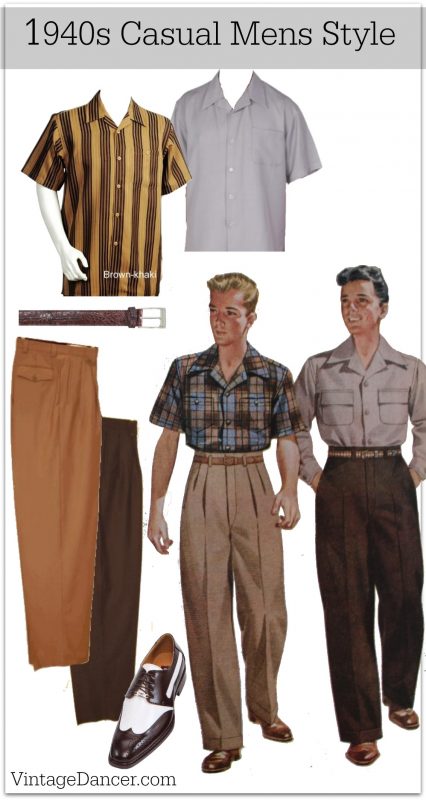Are you curious about how men dressed in the 1940s? The fashion of the 40s was more than just clothing—it was a statement of strength, style, and resilience.
Whether you want to add a touch of vintage charm to your wardrobe or simply understand the roots of modern men’s fashion, this article will guide you through the key trends and timeless looks of that era. Get ready to discover how your style can be inspired by the classic elegance and bold choices of men’s fashion from the 40s.
Keep reading, and you might find the perfect idea to upgrade your own look.
Key Fashion Elements
The 1940s was a defining decade in men’s fashion. The style was sharp and practical. Clothes reflected the times of war and recovery. Every detail had purpose and charm. Understanding key fashion elements shows why this era remains iconic.
Suit Styles And Fabrics
Suits in the 40s were broad-shouldered with a strong silhouette. Jackets had wide lapels and padded shoulders. Trousers were high-waisted and slightly tapered. Fabrics like wool and tweed were common. These materials offered durability and warmth. Dark colors like navy, gray, and brown dominated the palette.
Shirt And Tie Combinations
Shirts were mostly solid colors or subtle stripes. White and light blue shirts were popular choices. Ties were bold, often with geometric or floral patterns. The width of ties matched the broad lapels of suits. Knot styles varied but the four-in-hand knot was common. These combinations added personality without excess.
Footwear Choices
Shoes were sturdy and polished. Oxfords and brogues were the preferred types. Black and brown shades were standard. Leather quality was high to last through daily wear. Boots were worn in colder months or rougher conditions. Footwear balanced style with practicality in every step.

Credit: www.youtube.com
Influential Icons
The 1940s shaped men’s fashion in many ways. Influential icons set trends that men still admire today. Their styles showed strength, elegance, and confidence. These icons came from different fields. Each left a mark on how men dressed in the 40s.
Hollywood Stars
Hollywood stars were the face of 40s fashion. Men like Humphrey Bogart and Cary Grant wore sharp suits and fedoras. Their looks mixed class with a rugged charm. Movie costumes inspired everyday clothes for many men. The silver screen made tailored jackets and wide lapels very popular.
Military Influence
The war shaped men’s clothing in the 40s. Military uniforms brought practical styles to fashion. Double-breasted jackets, broad shoulders, and sturdy fabrics became common. Men adopted these looks for both work and casual wear. The military look gave a sense of discipline and pride.
Popular Musicians
Musicians of the 40s also changed men’s style. Big band leaders and jazz artists wore sleek suits and hats. Their style was lively and stylish. It mixed elegance with a bit of flair. Fans copied these looks to show their love for music and culture.
Casual Wear Trends
The 1940s brought a unique style to men’s casual wear. Clothes were practical yet stylish. Men wanted comfort without losing charm. Casual wear became simpler but still sharp. The look combined ease with a polished feel. Let’s explore the key trends of that era.
Sport Jackets And Sweaters
Sport jackets were a staple in the 40s. They often had broad shoulders and a slim waist. Fabrics like tweed and wool were popular. These jackets paired well with many outfits. Sweaters were equally important for casual looks. Men chose knitted or cardigan styles. They added warmth and a relaxed vibe. Colors stayed neutral or earthy, fitting the time.
Trousers And Casual Shirts
Trousers had a high waist and wide legs. This shape offered comfort and freedom to move. Men paired trousers with simple casual shirts. Cotton and flannel were common shirt materials. Shirts had button-down collars and often came in checks or stripes. The combination was easy to wear every day. It balanced neatness with casual ease.
Accessories For Everyday Style
Accessories completed the casual 40s look. Hats like fedoras or flat caps were popular. Men also wore leather belts with simple buckles. Pocket squares added a touch of personality. Watches were practical and classic in design. Sunglasses had round or square frames. These small details made casual outfits stand out.

Credit: www.mensfashionmagazine.com
Impact Of World War Ii
The impact of World War II on men’s fashion in the 1940s was profound. The war affected every part of life, including clothing. Men had to adapt to new styles shaped by the realities of war. Fashion became simpler, practical, and focused on function. These changes left a lasting mark on how men dressed during and after the 1940s.
Fabric Rationing Effects
Fabric rationing limited the amount of material available for clothing. Tailors used less fabric to make suits and shirts. Clothes became more fitted and less bulky. Designs were simpler, with fewer details. People reused old clothes and repaired them often. This made fashion more about utility than luxury.
Military Uniform Influence
Military uniforms inspired many fashion trends of the 1940s. Men’s suits featured broad shoulders and wide lapels, mimicking uniform cuts. Colors like navy, olive, and gray became popular. Pockets and sturdy buttons reflected military design. This style showed strength and discipline. It also made war veterans feel connected to their service.
Post-war Fashion Shifts
After the war, men’s fashion slowly changed again. The restrictions lifted, allowing more creativity. Men embraced brighter colors and new fabrics. Casual styles gained popularity as life became less strict. Yet, the military influence stayed in suit designs. The 1940s set the stage for modern men’s fashion trends.
Timeless Style Lessons
The 1940s men’s fashion offers style lessons that remain relevant today. This era focused on sharp, clean looks that suit many occasions. The key lessons come from classic shapes, smart colors, and perfect fit. These elements help create a polished and timeless appearance.
Classic Silhouettes
Men’s fashion in the 40s highlighted broad shoulders and narrow waists. Jackets were structured with padded shoulders and wide lapels. Trousers were high-waisted and loose at the top, tapering down to the ankles. This silhouette gave a strong, confident look. It still inspires modern suits and formal wear.
Color Palettes
The 40s used muted, earthy colors for a refined feel. Common shades included navy, brown, grey, and olive green. These colors matched well with many skin tones. They gave outfits a serious but stylish tone. Subtle colors make clothes easy to mix and match.
Tailoring And Fit
Fit was key in the 1940s. Clothes were tailored to fit the body closely without tightness. Jackets hugged the torso and sleeves ended just at the wrist. Pants were cut to sit comfortably on the hips and break just above the shoes. Proper tailoring created a neat and elegant look.

Credit: vintagedancer.com
Frequently Asked Questions
What Defined Men’s Fashion In The 1940s?
Men’s fashion in the 1940s was marked by practicality and style. Suits featured broad shoulders, narrow waists, and wide lapels. Fabrics were often wool or tweed, reflecting wartime rationing. Accessories like fedoras and pocket squares were popular, adding sophistication to everyday looks.
How Did World War Ii Influence 1940s Men’s Style?
World War II led to fabric rationing, influencing simpler, more functional designs. Military uniforms inspired civilian clothing, emphasizing durability and utility. This era saw a rise in double-breasted suits and practical footwear. The war also popularized khaki and olive drab colors in men’s fashion.
What Were Popular Accessories For Men In The 40s?
Popular accessories included fedoras, pocket watches, and suspenders. Ties often featured bold patterns and wide widths. Leather gloves and cufflinks added a touch of elegance. These accessories complemented the structured suits and completed the polished 1940s look.
How Did Men’s Casual Wear Evolve In The 1940s?
Casual wear became more relaxed but still tailored. Sweaters, cardigans, and high-waisted trousers gained popularity. Polo shirts and patterned shirts were common for informal occasions. This shift reflected a balance between comfort and the era’s formal style standards.
Conclusion
Men’s fashion of the 40s shows style and simplicity. Suits had strong lines and neat cuts. Hats and ties added smart touches. Clothes balanced comfort with formality well. This era inspires modern vintage looks. Classic pieces remain popular today. Remember, dressing from the 40s means confidence and neatness.
Try mixing old styles with new clothes. That way, you keep the charm alive. Fashion always tells a story. The 40s story is timeless and strong.

